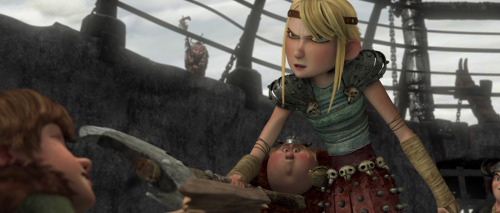In the HTTYD franchise, female characters Astrid Hofferson, Ruffnut Thorston, and Heather from the TV series are all very reminiscent of the Viking shield-maidens of legend. Each character is a formidable warrior within her own right and is able to demonstrate more military prowess than much of the male cast. Astrid’s combat skills in particular surpass that of almost all the other characters in the movies/TV series. Compared to the inventive yet physically weak Hiccup, nerdy gamer Fishlegs, dimwitted Snotlout, and exasperating Tuffnut, the girls are presented as the backbone of the group and as some of their best riders. The use of the shield-maiden in fiction is common and the legend is well-known. However, the question of whether or not these warrior women did, in fact, live and fight in the Middle Ages is still contested by historians.

Astrid threatening Hiccup with her axe after he screws up during dragon training.
While some Viking sagas tell tales of women who could wield a weapon, such as Brynhildr Buðladóttir, Freydís Eiríksdóttir (Leif Erikson’s sister), and Lagertha (the first wife of the legendary Ragnar Lodbrok), the reality of the existence of shield-maidens is much harder to ascertain. The majority of the sources that describe these warrior women are questionable as to their accuracy, as oftentimes they are written very long after the supposed events of the narrative and do not concern themselves with documenting accurate history as opposed to a fantastical account of events that elevates a person or family’s societal standing. The shield-maidens’ further connection with folkloric literature can be gathered from their likeness to the Valkyries, or the handmaidens of Odin who choose which fallen warriors to bring to Valhalla. Because of the difficulties in determining which parts of the sagas are historically accurate and which are falsified, it is hard to make a definite case for the existence or nonexistence of the shield-maiden.

A painting by Peter Nicolai Arbo depicting the death of shield-maiden Hervor in the Hervarar saga
While the usage of shield-maidens in modern literature and media may not be the most historically accurate in terms of events that occurred in the past, it does do justice to the concept of shield-maiden that appears in the literature of the Middle Ages. Astrid of HTTYD may not have been a woman of the Viking age in reality, but she bears a striking resemblance to Saxo Grammaticus’s Viking shield-maiden Lagertha and her courage and valor in battle. In this sense, the shield-maiden is an easily well-utilized aspect of medieval literature that is taken advantage of by the creators of today’s media.
You must be logged in to post a comment.